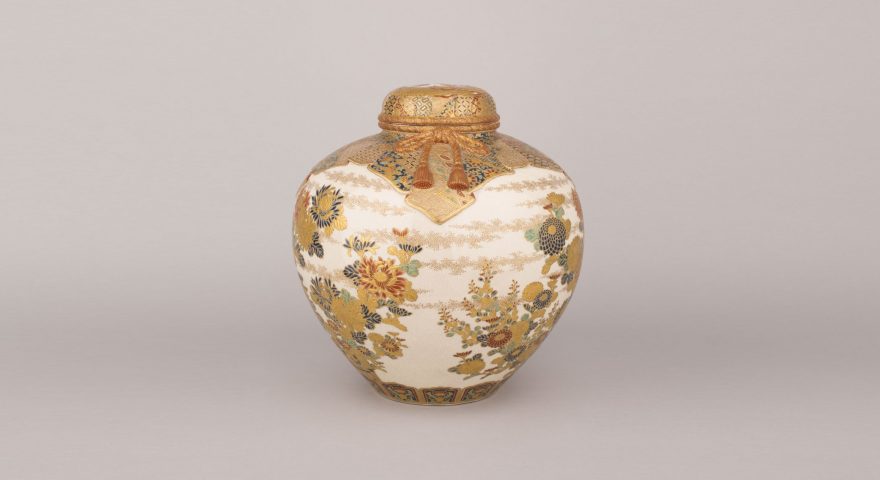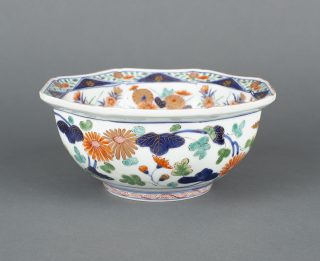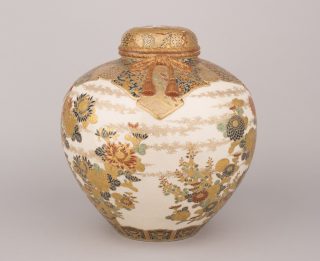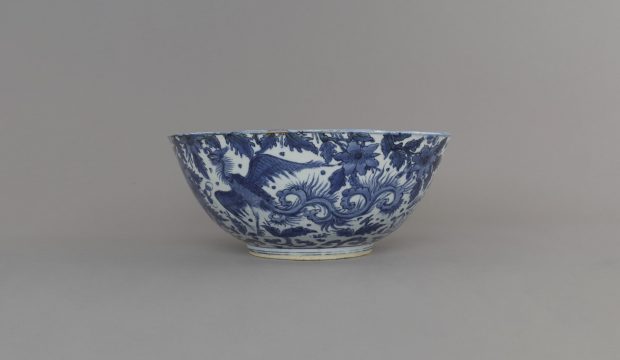Japanese Ceramics – An Introduction
Like Japanese culture and history, the story of Japanese ceramics is a richly-woven tale dating back many thousands of years. It is one of the most famous of all Japanese art forms and in the world-renowned Japanese tea ceremony, Japanese porcelain holds a revered place.
As with most early artforms, each region – or prefecture – developed their own style of making Japanese ceramics with unique aesthetics based on the type of clay in the area, the glaze used and the firing methods. There are dozens of famous towns making Japanese ceramics all over the country and many, if not most, are either still active or have fantastic museums dedicated to their art history.
The Difference Between Antique Japanese Pottery and Japanese Porcelain
All Japanese ceramics, pottery and stoneware are named according to where they come from but they can be grouped into larger categories known simply as toki (pottery) and jiki (porcelain).
Toki
This style of Japanese pottery is made predominantly of kaolin clay and is fired at temperatures between 700°C and 1200°C. After the shape has been set it is often painted with a glaze called yuyaku which creates a glossy finish and waterproofs the vessel.
Jiki
This type of Japanese porcelain is made from crushed pottery stone and fired at higher temperatures, up to 1300°C because the mineral content of the stone has to crystallise. It is lighter and harder than toki and is usually formed of a white base with bright colours and vibrant patterns painted over the top.
The Most Famous Types of Japanese Ceramics
As we mentioned, each of Japan’s 47 prefectures produced it’s own type of ceramics using local materials. It’s for this reason that all Japanese ceramics are named for their places of origin. The three most famous types of antique Japanese pottery are Imari ware, Seto ware and Mino ware.
Imari ware
Perhaps the most famous of all Japanese ceramics, it is called Imari ware (Imari-yaki) because it was shipped all over the world from the port of Imari but in fact it hails from the western Japanese town of Arita. Ceramics, including the famous antique Japanese vase, were deeply influenced by the blue and white pottery from China and is admired amongst collectors for it’s light, white body and vivid colours.
Seto ware
With 1,000 years of history, Seto-yaki pre-dates Imari ware and the first man credited with producing ancient Japanese pottery in the area was Katō Shirōzaemon Kagemasa (known as Tōshirō) in the 1220s who founded what became one of the Six Ancient Kilns of Japan. Seto ceramicists were among the first to glaze their earthenware and Seto ware has since become some of the most collectible and revered of all Japanese ceramics.
Mino ware
Many of the most famous craftsmen of Mino ware (Mino-yaki) came from Seto to escape the ravaging wars of the Azuchi-Momoyama period (1568 – 1614) and thanks to an abundance of kaolin clay in the region, it has emerged into one of the most productive areas of Japanese ceramic manufacture. In fact the history of Mino ware dates back over 1,300 years with the discovery of ancient Japanese stoneware in the area.
Antique Japanese Pottery – The History
The very earliest form of ceramics was Japanese stoneware and examples have been unearthed from around 10,000 years ago during the hunter-gatherer Jōmon period (c.14,000 – 300 BC). In fact the word ‘Jōmon’ translates as ‘cord-marked’ (as coined by American orientalist Edward Morse) and describes Japanese pottery decorated by impressing fabric cords into wet clay and then fired. This is one of the very oldest styles of pottery in the world.
As with most inherently cultural artforms, the history of Japanese ceramics is also the history of Japan’s religions, belief systems, cultural and national values and it’s dynasties, wars, successes and failures.
Japanese Ceramics Through the Ages
As the Jōmon period made way for the Yayoi period (approximately 300 BC – 300 AD and from where around 90% of modern Japanese can trace their ancestry), the style of Japanese ceramics from this period was very basic, with either simple patterns or no patterns at all.
The Kofun period (c. 300 AD – 538 AD) saw the country unified under a single kingdom. The potters of the age created tunnel – or anagama – kilns which were roofed tunnels on a sloped hillside and could produce Japanese stoneware, known as Sue, a blue-grey form of Japanese pottery fired at around 1,200 – 1,300°C. There are artisans in a number of rural towns that still produce stoneware in the same way today.
Later, in the Heian period (794 AD – 1185 AD), the capital of Japan moved to modern-day Kyoto where it remained until 1868. It was during the eighth century that a three-colour glaze technique was introduced into Japanese porcelain via China’s Tang dynasty craftsmen. It was also during this time that some very distinctive regional styles appeared including Kamui ware (grey stoneware), Atsumi ware (which included some of the most beautiful examples of the antique Japanese vase) and Tokonami ware, one of the Six Ancient Kilns that made some of today’s most sought-after pieces of Japanese ceramic ware in the world.
Much of the ceramics produced during the Kamakura period (1185 – 1333) were as a result of the Chinese schooling of Tōshirō and there were a number of kilns that imitated Chinese porcelain as well as developing glazes such as ash brown, feldspar white, copper green and iron black.
For almost 400 years between around 1200 to the late 1560s (taking in the Kamakura and Muromachi periods), much of the highly-valued ceramics were Chinese, known as karamono or ‘Chinese things’. However in the latter half of the sixteenth century, the rise of Buddhism heralded a return to much simpler stye of Japanese ceramics, as demonstrated by their use by tea masters in the world-famous tea ceremony.
The seventeenth century saw a marked increase in the manufacture of Japanese porcelain and Japanese ceramics as international markets opened. As with Ming porcelain from China, blue-and-white Japanese porcelain was highly prized by Europe’s wealthy. At the start of the Edo period (1603 – 1868), there was a strong worldwide demand for Japanese ceramics – pieces designed specifically for the foreign market – and during the eighteenth and nineteenth centuries, the Dutch East India Company imported huge volumes of Japanese porcelain into Europe, even during the later Edo’s isolationist foreign policy.
In the latter years of the nineteenth and the early years of the twentieth century, the Meiji government encouraged westernisation which had a detrimental effect on the traditional and artisan craftsmen. After trade deals were signed with America, Holland, Russia, France and the UK, Japanese ceramics were to be made in industrial volumes and entrepreneurs flocked to the port areas to set up businesses to take advantage of these new markets.
Antique Japanese Pottery – The Present Day
After World War II, there was a steep decline in the production and indeed popularity of Japanese ceramics – yakimono – and in the space of just a single generation, Japan’s pottery heritage almost died out entirely. It was an elite artform but considered very traditional. However, a mid-20th century philosopher named Yanagi Sōetsu postulated about Japanese ceramics that ‘even humble goods could be inherently beautiful’ and artists up and down the country found ways of keeping true to thousands of years of Japanese cultural tradition while keeping pace with the societal changes that were happening.
Thanks in part to the commitment of Sōetsu, kilns today are making some truly stunning pieces of Japanese porcelain. If you walk into any yakitori restaurant, izakaya bar or sushi bar you will find beautiful pieces of Japanese ceramics on your table, from the plates to the small sauce dishes, or mamezara, to the sake cups and even the hashioki, the chopsticks holders.
For thousands of years, the design and creation of beautiful pieces of antique Japanese pottery of all types was a vital aspect of Japanese life. The historical and regional traditions continue to flourish and Japanese ceramics are as ubiquitous to Japanese society as lotus flowers or sushi.




























